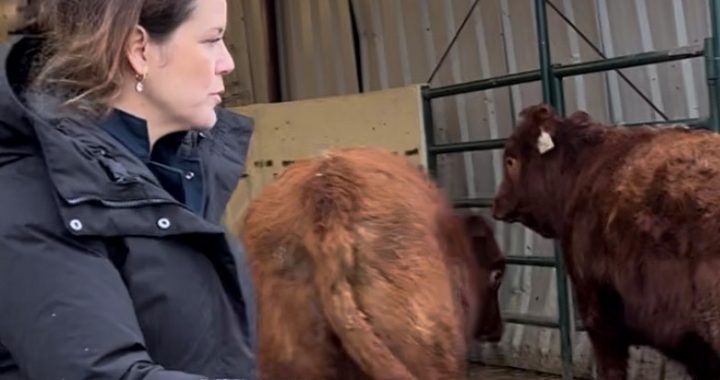“I became fascinated about how we might increase the profitability of the livestock industry simply by improving the welfare of farm animals in Brazil,” says Désirée Gellatly, Research Scientist at the Olds College Technology Access Centre for Livestock Production. “Mostly, when we interact with animals—for vaccinations, health treatment, ear tags, etc.—it’s an adverse stimulus. There must be other ways of doing these procedures without causing animals to be frightened of us in the next handling occasions.”
Back in Brazil, Dr. Gellatly was part of a research group studying best practices to improve the productivity, health, and welfare of dairy calves. One of the studies involved assessing tactile stimulation in newborn calves by gently rubbing the hands on their body to mimic maternal stimulation, such as licking and grooming. The licking behaviour performed by the cow cleans the calf, induces calf thermal regulation and creates a bond between the cow-calf pair. Briefly, all mammals have a specialized type of nerve receptors in the skin which signal the brain to perceive a nonpainful stimuli (such as massage-like gentle stroking) as “affective” and “pleasant” sensations. Evidence shows that tactile stimulation performed by humans in laboratory animals permanently affected brain development (more synapses) and the HPA axis,which mediates stress responses. More positive sensory interaction in early life, less secretion of stress hormones – so less fight-or-flight response in adulthood. These changes are permanent.
“All mammals and birds have a window in brain development where the brain is more sensitive to environmental influences,” says Désirée. “In humans, this window is enhanced in the first five years of age. That’s why young kids learn languages better than adults. It’s also why babies are given to mom immediately after birth… to start the sensory interaction that helps brain development.”
Why and how do you pet/massage a calf? The most sensitive period of brain development in calves is in the first week. So, we recommend immediately after processing the calves (weighing, ear tagging, vaccination, and injections), to apply gentle but firm pressure (avoid light tickle touches) with your hands around the legs, back and areas that the cow would lick.
Désirée has been working with Lance and Karyn Neilson of Neilson Cattle Development near Stettler, AB, on this approach. In their first study, half the newborn calves got just one single occasion of 1-minute massage after processing procedures at 1-day of age. The massaged calves required 20% less treatments for illnesses over time, and, at weaning, were 47 lb. heavier than the unmassaged calves.
“It’s interesting that recent studies in Brazil on zebu beef cattle are finding the same results,” says Désirée. “Studies in laboratory animals attribute the greater growth performance in massaged animals to the greaterexploratory behaviour observed in those animals compared to control groups, perhaps because their brain develops differently, so they start eating solids earlier.”
A second study on the Neilson’s ranch compared different weaning methods: abrupt separation, nose-flap,and fenceline weaning. The fenceline approach was best for improving growth and reducing illness post-weaning. The nose-flap method raised some welfare concerns due to the high incidence of animals with skin lesions in both nostrils that last up to 14-days after removing the devices.
All that is fine for calves but the Neilsons also wanted to improve the reproductive efficiency of their herd. So came the third study , which resulted in much calmer heifers after acclimation to handlingand a 2-3% higher pregnancy rate compared to the control group. A validation study a year later produced a 10.8% better pregnancy rate in acclimated heifers compared to the non-acclimated control group.
“Now the acclimation procedure is permanent on this farm,” confirms Désirée. “Lance and Karyn found value in it. They were worried it would take too much time out of their day so I checked. With just the two of them, it took 15 minutes a day to acclimate 100 animals. I believe it’s doable for most producers in Western Canada!”
Désirée’s next step is to assess whether the benefits of tactile stimulation in newborn calves comes from the treatment “massage”, not from the genetics (sire). She’s planning to apply for project funding in collaboration with Gentec to find out exactly that.
“Cattle don’t do well in new situations,” she says. “If we can reduce their fear from day one through best practices and make it worthwhile for the producer, it’s got to be a win-win.”

